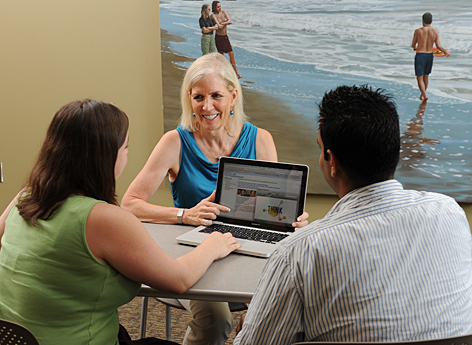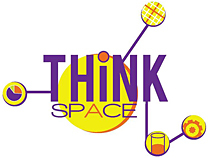
Holly Bender (center), a professor of clinical pathology in Iowa State's College of Veterinary Medicine and associate director in the Center for Excellence in Learning and Teaching, works on ThinkSpace with Meghan Gillette and Sri Manchiraju, two students from her Preparing Future Faculty class. Photo by Bob Elbert, ISU News Service
AMES, Iowa -- Jay Newell, an associate professor in Iowa State University's Greenlee School of Journalism and Communication, calls ThinkSpace "the greatest thing since sliced bread" in terms of getting into the heads of his students.
Holly Bender, a professor of clinical pathology in Iowa State's College of Veterinary Medicine, knows that ThinkSpace better trains her students to be able to read an ailing animal's symptoms and lab results in order to make a more accurate diagnosis.
And Dale Niederhauser, an associate professor in the Iowa State School of Education, says ThinkSpace better prepares his students for the problems they may encounter in their future classrooms.
They're three of more than 50 ISU faculty members across a number of disciplines who are now teaching classes with ThinkSpace, an interactive online teaching resource developed at Iowa State that encourages students to think critically about the solutions to complex, real-world problems. And because of its initial success at Iowa State, ThinkSpace is now being exported for use to colleges and universities around the world.
Bender says she's been making presentations all summer to institutions that will adopt ThinkSpace this fall, including The Ohio State University, Michigan State University, Colorado State University and the University of Calgary, among others.
ThinkSpace emerges from two similar teaching tools
Bender was on the ground floor of ThinkSpace's development because of success of a similar online teaching resource she developed at Virginia Tech, the Diagnostic Pathfinder, which helped veterinary students learn to interpret lab data more accurately when making diagnoses. In the past few years, Bender learned that other Iowa State faculty -- including Craig Ogilvie, assistant dean of the Graduate College and professor of physics in the College of Liberal Arts and Sciences; and Ann Marie VanDerZanden, a professor of horticulture and director of the Center for Excellence in Learning and Teaching (CELT) -- were using a similar learning platform, The Problem Solving Learning Portal.
"They [Diagnostic Pathfinder and The Problem Solving Learning Portal] were different, but they were both designed to tackle complex problem-solving," said Bender, CELT associate director.
So Bender, Ogilvie, Niederhauser, Jared Danielson, an associate professor in veterinary pathology; and John Jackman, an associate professor of industrial and manufacturing systems engineering; led a faculty effort to see if Iowa State's Information Technology Services (ITS) could develop something for more universal use across multiple disciplines. And when Pete Boysen, a senior systems analyst at ITS, made that a reality, ThinkSpace was born some two years ago.
"Pete (Boysen) had a vision to help us all become sustainable and helped many of us come together," Bender said.
Through the program, faculty members ask students to think critically about the answers to problems they pose through the program. Each case (problem) can incorporate related information, interactivity with faculty and fellow students, automated feedback and media.
"By using real-world scenarios, it allows students to work through electronic platforms and permits faculty to see how they [the students] arrive at their final solutions," said Jim Twetten, director of ISU's Information Technology Services (ITS), academic technologies. "The thing about an authentic learning environment like ThinkSpace is you have to think about all the things you need and don't need while working through the problem."
Students already tackling some tough problems
Iowa State students have already used ThinkSpace to tackle issues related to such topics as global warming, classroom cheating, veterinary diagnostics and marketing decisions. Complex problems may be broken down into a series of smaller steps that the instructor can control, releasing more information and questions as the student progresses.
"This tool actually makes your pedagogy come alive with your students and it supports them being able to do complex problem-solving, be successful at it, and get feedback for it," Bender said. "It really structures it in a way that it helps the students learn. And it supports teamwork and peer evaluation very well, too."
Because students work through authentic problems that they may encounter in their future careers, ThinkSpace better prepares them to transition to their post-graduation employment.
"I like to think of it as real-world challenges people face rather than problem-solving," said Niederhauser, a faculty member in the Center for Technology in Learning and Teaching who contributed to the ThinkSpace development team through his background in the learning sciences.
"This becomes a much more contextualized, complex, learning situation because there aren't easy answers in the real world," he said. "We're trying to help our students begin to think more in a global environment and less in a school-based environment where everything is cut and dried from the book and there are right answers and wrong answers."
